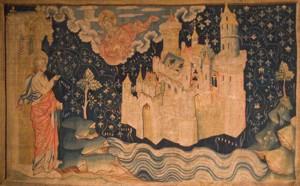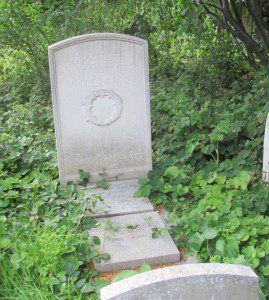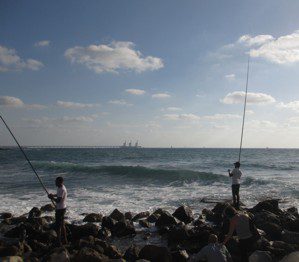 The book of Revelation also known as the Apocalypse of John can be rather hard to understand. It is, after all, apocalyptic literature – a form a bit ‘interesting’ in the Old Testament prophets and every bit as ‘interesting’ here. I don’t usually worry too much about the book, or try too hard to make sense of it. This isn’t to say it should be ignored or bypassed (I’ve listened to it several times through over the last couple of years along with the rest of the Bible) – just to say that the appropriate interpretation seems somewhat obscure for the most part. But it is a book worth some consideration, so I turned with interest to the chapter in Let Creation Rejoice: Biblical Hope and Ecological Crisis by Jonathan Moo and Robert White where they look at John’s vision.
The book of Revelation also known as the Apocalypse of John can be rather hard to understand. It is, after all, apocalyptic literature – a form a bit ‘interesting’ in the Old Testament prophets and every bit as ‘interesting’ here. I don’t usually worry too much about the book, or try too hard to make sense of it. This isn’t to say it should be ignored or bypassed (I’ve listened to it several times through over the last couple of years along with the rest of the Bible) – just to say that the appropriate interpretation seems somewhat obscure for the most part. But it is a book worth some consideration, so I turned with interest to the chapter in Let Creation Rejoice: Biblical Hope and Ecological Crisis by Jonathan Moo and Robert White where they look at John’s vision.
The view that shapes their interpretation is that the vision of John describes a redemption and renewal of creation rather than a destruction of all things. This vision starts with the song of praise to the Lion of Judah, the root of David, the Lamb who was slain and is able to open the scroll.
“You are worthy to take the scroll
and to open its seals,
because you were slain,
and with your blood you purchased for God
persons from every tribe and language and people and nation.
You have made them to be a kingdom and priests to serve our God,
and they will reign on the earth.” (5:9-10)
Here as elsewhere in John’s vision, Christ’s atonement does not serve to open “escape hatches” for the redeemed to ascend to heaven; rather Christ ransoms for God a people, a “priestly kingdom,” who will reign on earth. … In the light of the death, life, resurrection, and future return of the incarnate Christ, readers of John’s Apocalypse are enabled to see this world through new eyes and to go about the work to which God calls us: to be here, As Wendell Berry’s poem at the head of this chapter suggests,
As we have never been before,
Sighted as not before, our place
Holy, although we knew it not. (p. 147)
The book of Revelation is a book of hope, and John’s vision with its upheaval, chaos, and judgment is “the inevitable consequences of the encounter between God’s righteousness and the forces of evil and injustice.” The victory has been won, but we await the final restoration.
Babylon the Great. Chapter 17-19 of the Apocalypse deals with the fall of Babylon the Great – that is Rome. Rome was the empire, it was the power of this world for of John and his original audience. The references within the book are many and they wouldn’t be missed by the ancient reader. It was Rome who destroyed the temple leading to the death of thousands. It was the Roman emperor who was venerated and worshiped as a god. It was Domitian who referred to himself as “our Lord and God.” The prostitute Babylon the Great of chapter 17 rides a beast with seven heads … which are seven hills. Rome was built on seven hills … the connection isn’t explicit, but it isn’t actually hidden either.
According to Moo and White, “John’s vision challenges the readers to resist the siren calls of our culture that would invite us to worship money, power, and empire.” (p. 149) This theme is present, but sometimes hard to pick up in chapters 6-16 (hard for the modern reader anyway) but is driven home in 17-19. And this should make us squirm. “We may not live in Rome, but our consumerist societies can look an awful lot like Babylon.” (p. 152)
The seductive nature of the power and wealth of Babylon (Rome) is revealed in Chapter 17 when John wondered to marveled when he saw the prostitute, and the list of goods traded by her merchants in chapter 18 provide some insight into why. The angel asks why John marvels and proceeds to explain the mystery to him. “If John recognizes in himself the temptation to buy into the lie that is Babylon, he knows that his readers face the same temptation.” (p. 153)
God’s people do not live somewhere other than Babylon; in this age it is the place of their exile. But they are challenged nonetheless to “come out” from all that Babylon represents, to demonstrate that there citizenship is elsewhere. God’s people are not immune to Babylon’s charms: like anyone else they are at risk of finding themselves enmeshed in the worship of power, wealth, and luxury that defines the culture and society in which they live. The challenge for John’s readers is the same as it was for those who heard Jeremiah when he issued the same call to the exiles in the original Babylon (Jer 51:45): to refuse to worship the idols of empire and keep from participating in her sins and falling under the judgment that must surely befall her. (p. 153-154)
Our call today is no different. It is to examine the orientation of our lives, our tendency to invest our lives in the pursuit of wealth and power, and to refuse to worship the idols of empire. Moo and White suggest that the emphasis on consumption that is leading us toward an ecological crisis is the idol of empire today. “[T]he earth continues to be polluted and destroyed to sustain our way of life.” (p. 154)
A New Earth. Revelation describes not the abandonment and destruction of God’s creation, but a reordering of creation around its proper center. There is a regime change, a change that has begun but it not yet complete. The proclamation of this regime change began in Revelation 11:15-18 and it is described in greater detail in chapters 21-22. John echoes Isaiah and Ezekiel with his own overwhelming imagery and the new understanding of the reconciling work of the blood of the lamb. God isn’t making new things, but is making all things new (Rev 21:5).
 Moo and White move on to look at the things that are no longer (p. 158) …
Moo and White move on to look at the things that are no longer (p. 158) …
the sea (21:1)
death (21:4)
mourning (21:4)
crying (21:4)
pain (21:4)
curse (22:3)
night (22:5)
The central three things on this list, mourning, crying and pain, are all marks of a world held hostage to death and plagued by its curse. They are no more when death itself is swallowed up and “any curse” is removed. … In new creation, the curse and death that mark life in this age are gone and the conditions that were meant to apply in the Garden of Eden are restored. Yet John’s vision of a new creation is not merely of a world in which the clock is turned back to its beginning; it is rather of a world taken forward to the future God always intended for it. (p. 158-159)
 But the sea and the night were not problems in Genesis. Rather they were a part of God’s good creation, and the sea is still a part of God’s good creation earlier in Revelation. This is one of the conundrums of the text and an issue that points us to the future and away from overly literalistic interpretations (always dangerous in apocalyptic literature anyway). The sea represents chaos and judgment in many parts of the Old Testament. Night is also a time of chaos and danger. Doing away with sea and night meant “for John’s readers the removal of all threat of judgment, all potential for evil to arise in the new creation.” (p. 160)
But the sea and the night were not problems in Genesis. Rather they were a part of God’s good creation, and the sea is still a part of God’s good creation earlier in Revelation. This is one of the conundrums of the text and an issue that points us to the future and away from overly literalistic interpretations (always dangerous in apocalyptic literature anyway). The sea represents chaos and judgment in many parts of the Old Testament. Night is also a time of chaos and danger. Doing away with sea and night meant “for John’s readers the removal of all threat of judgment, all potential for evil to arise in the new creation.” (p. 160)
The future is described on the basis of what is now known, and what is wrong with the present. What is wrong (chaos, evil, death) will be removed when God’s kingdom is fully realized, when the regime change has come to completion. But the other important point is that the future kingdom is not only future, it is beginning to be realized even now … in the time of John and up to the present. It breaks through in the people of God who come out from all that Babylon represents.
So what does this mean? I find the image that Moo and White portray of the broad sweep of the message of the Apocalypse of John compelling. It makes a great deal more sense than the end-of-the-world scenario often portrayed.
We need to recognize the centrality of Rome and empire worship in the message being delivered. I am not convinced that we should see a reaction to empire worship throughout the New Testament, but it certainly is present in Revelation.
It probably isn’t coincidence that the form of the vision of John resembles the visions of the prophets during the exile in Babylon. (Why would it be?) The connection was powerful for the original audience, although often lost in more recent readings. For one thing, I’ve never heard a sermon that emphasized the similarity of apocalyptic visions in the Old and New Testament, yet this is one of the many things that have impressed me in my recent commitment to be immersed in the whole of scripture from Genesis through Revelation. We can’t understand John without knowing Isaiah, Ezekiel and Daniel (and perhaps some others I am forgetting just now).
I am not convinced that it has any specific bearing on the Christian response to ecological crisis or environmental concerns – except perhaps to remove the excuse that the world will be destroyed anyway. The Scripture isn’t speaking directly to the concerns of a 21st century industrial society, although there are certainly take-home messages for us today.
The final chapter of Let Creation Rejoice may bring us forward on the specific topic of biblical hope and ecological crisis. That will be the subject of the next, and final, post on the book.
What is the take-home message of Revelation for us today?
Should we be looking for the end of the world or the consummation of God’s kingdom?
What will change when God’s kingdom is realized on earth?
If you would like to contact me directly you may do so at rjs4mail[at]att.net.
If interested you can subscribe to a full text feed of my posts at Musings on Science and Theology.











